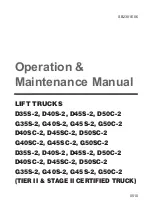
The hydraulic system has hydraulic oil tank (10) which
holds the oil for gear type hydraulic pump (15).
Hydraulic pump (15) sends pressure oil the power
brakes (if equipped), hydraulic and steering systems.
Pump oil flows from pump (15) to priority valve (11)
where the oil folw divides to the power brakes brake
valve (if equipped)(not shown) through line (12) and to
the steering gear through line (16). Oil also flows
through anti-stall valve (20), to hydraulic control valve
(5) and back to hydraulic tank (10).
When the lift truck is at idle speed the hydraulic pump
delivers a low oil flow. If the lift, tilt or auxiliaries are
used the pressure in line (17) will increase and
remote relief valve (18) will dump oil to hydraulic tank
(10). As engine speed is increased, oil flow
increases, anti-stall valve (20) now closes the
passage to remote relief valve (18). With remote
relief valve (18) blocked, normal hydraulic relief
pressures are available.
The control valve levers move the valve spools in
control valve (5) to let the pump oil in the control
valve go to lift cylinders (1) and/or (22), tilt cylinders
(6) or sideshift cylinder(s) (3).
The return hydraulic oil from the cylinders flows
through hydraulic control valve (4), line (13), into filter
(9) and hydraulic tank (10). Relief valve (7) in the
control valve body will make the flow control valve
release extra pressure to the hydraulic tank when the
pressure in the lift or tilt circuits goes higher than
relief valve pressure shown in the Control Valve
section of Specifications. Relief valve (8) does the
same thing for the sideshift circuit when it goes
higher than the auxiliary relief valve pressure shown
in the Control Valve section of Specifications.
12 of 29
New Hydraulic Systems
Systems Operation
Summary of Contents for D20S-2
Page 8: ......
Page 13: ......
Page 24: ...27 of 29 New Hydraulic Systems Disassembly and Assembly IDCS015B...






























